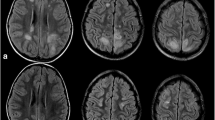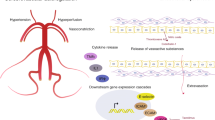Abstract
Background
Posterior reversible encephalopathy syndrome (PRES) is a well-recognized clinico-neuroradiological transient condition. Early recognition is of paramount importance for prompt control of blood pressure or removal of precipitating factors and treatment of epileptic seizures or status epilepticus. Delay in the diagnosis and treatment may in fact results in death or in irreversible neurological sequelae.
Discussion
PRES is characterized by headache, altered mental status, seizures, and visual disturbances and is associated with a number of different causes, most commonly acute hypertension, preeclampsia/eclampsia, and immunosuppressive agents. Clinical symptoms and neuroradiological findings are typically indistinguishable among the cases of PRES, regardless of underlying cause. Magnetic resonance studies typically show edema involving the white matter of cerebral posterior regions, especially parieto-occipital lobes but frontal and temporal lobes, and other encephalic structures may be involved.
Conclusions
Intensivists and other physicians involved in the evaluation of patients with presumed PRES must be aware of the clinical spectrum of the associated conditions, the diagnostic modalities, and the correct treatment.

Similar content being viewed by others
References
Hinchey J, Chaves C, Appignani B, Breen J, Pao L, Wang A, Pessin M, Lamy C, Mas JLM, Caplan LR (1996) A reversible posterior encephalopathy syndrome. N Engl J Med 334:494–500
Casey SO, Sampaio RC, Michel E, Truwit CL (2000) Posterior reversible encephalopathy syndrome: utility of fluid-attenuated inversion recovery MR imaging in the detection of cortical and subcortical lesions. AJNR Am J Neuroradiol 21:1199–1206
Kwon S, Jahoon K, Sangkwon L (2001) Clinical spectrum of reversible posterior leukoencephalopathy syndrome. Pediatr Neurol 24:361–364
Pavlakis SG, Frank Y, Kalina P, Chandra M, Lu D (1997) Occipital-parietal encephalopathy: a new name for an old syndrome. Pediatr Neurol 16:145–148
Kastrup O, Maschke M, Wanke I, Diener HC (2002) Posterior reversible encephalopathy syndrome due to severe hypercalcemia. J Neurol 249:1563–1566
Maramattom BV, Zaldivar RA, Glynn SM, Eggers SD, Wijdicks EF (2005) Acute intermittent porphyria presenting as a diffuse encephalopathy. Ann Neurol 57:581–584
Covarrubias DJ, Luetmer PH, Campeau NG (2002) Posterior reversible encephalopathy syndrome: prognostic utility of quantitative diffusion-weighted MR images. AJNR Am J Neuroradiol 23:1038–1048
Schaefer PW, Buonanno FS, Gonzales RG, Schwamm LH (1997) Diffusion-weighted imaging discriminates between cytotoxic and vasogenic edema in a patient with eclampsia. Stroke 28:082–1085
Koch S, Rabinstein A, Falcone S, Forteza A (2001) Diffusion weighted imaging shows cytotoxic and vasogenic edema in eclampsia. AJNR Am J Neuroradiol 22:1068–1070
Casey SO, McKinney A, Teksam M, Liu H, Truwit CL (2004) CT perfusion imaging in the management of posterior reversible encephalopathy. Neuroradiology 46:272–276
Johansson B (1974) Regional cerebral blood flow in acute experimental hypertension. Acta Neurol Scand 50:366–372
Haggendal E, Johansson B (1972) On the pathophysiology of the increased cerebrovascular permeability in acute arterial hypertension in cats. Acta Neurol Scand 48:265–270
Auer L (1978) The sausage-string phenomenon in acutely induced hypertension—arguments against the vasospasm theory in the pathogenesis of acute hypertensive encephalopathy. Eur Neurol 17:166–173
Ekstrom-Jodal B, Haggendal E, Linder LE, Nillson NJ (1971) Cerebral blood flow autoregulation at high arterial pressures and different levels of carbon dioxide tension in dogs. Eur Neurol 6:6–10
Schwartz RB, Feske SK, Polak JF, DeGirolami U, Iaia A, Beckner KM, Bravo SM, Klufas RA, Chai RY, Repke JT (2000) Preeclampsia-eclampsia: clinical and neuroradiographic correlates and insight into the pathogenesis of hypertensive encephalopathy. Radiology 217:371–376
Byrom F (1954) The pathogenesis of hypertensive encephalopathy and its relation to the malignant phase of hypertension: experimental evidence from the hypertensive rat. Lancet 2:201–211
Strangaard S, Jones JV, MacKenzie ET, Graham DI, Farrar JK (1976) The sausage-string pattern in the pial vessels in acute, angiotensin-induced hypertension-vasospasm or vasodilatation? Acta Med Scand Suppl 602:9–12
Chester EM, Agamanolis DP, Banker BQ, Victor M (1978) Hypertensive encephalopathy: a clinicopathologic study of 20 cases. Neurology 28:928–939
Richards A, Graham D, Bullock R (1988) Clinicopathological study of neurological complications due to hypertensive disorders of pregnancy. J Neurol Neurosurg Psychiatry 51:416–421
Schiff D, Lopes MB (2005) Neuropathological correlates of reversible posterior leukoencephalopathy. Neurocrit Care 2:303–305
Kaplan PW (2002) Neurologic aspects of eclampsia. In: Hainline B and Devinsky O (eds) Neurological complications of pregnancy, 2nd edn. Lippincott Williams & Williams, pp 41–49
Mednick AS, Mayer SA (2002) Critical care management of neurologic catastrophes. In: Hainline B and Devinsky O (eds) Neurological complication of pregnancy, 2nd edn. Lippincott Williams & Williams, pp 87–101
Weidauer S, Gaa J, Sitzer M, Hefner R, Lanfermann H, Zanella FE (2003) Posterior encephalopathy with vasospasm: MRI and angiography. J Neurol 45:869–876
Ito Y, Arahata Y, Goto Y (1998) Cisplatin neurotoxicity presenting as reversible posterior leukoencephalopathy syndrome. Am J Neuroradiol 19:415–417
Antunes NL, Small TN, George D, Boulad F, Lis E (1999) Posterior leukoencephalopathy syndrome may not be reversible. Pediatr Neurol 20:241–243
Servillo G, Striano P, Striano S, Tortora F, De Robertis E, Rossano F, Briganti F, Tufano R (2003) Posterior reversible encephalopathy syndrome (PRES) in obstetric critically ill patients. Intensive Care Med 29:2323–2326
Friese S, Fetter M, Küker W (2000) Extensive brainstem oedema in eclampsia: diffusion-weighted MRI may indicate a favourable prognosis. J Neurol 247:465–466
Digre KB, Varner MW, Osborn AG, Crawford S (1993) Cranial magnetic resonance imaging in severe preeclampsia vs eclampsia. Arch Neurol 50:399–406
Keswani SC, Wityk R (2002) Don't throw in the towel! A case of reversible coma. J Neurol Neurosurg Psychiatry 73:83–84
Zeeman GG, Fleckenstein JL, Twickler DM, Cunningham FG (2004) Cerebral infarction in eclampsia. Am J Obstet Gynecol 190:714–720
Solinas C, Briellmann RS, Harvey AS, Mitchell LA, Berkovic SF (2003) Hypertensive encephalopathy. Antecedent to hippocampal sclerosis and temporal lobe epilepsy? Neurology 60:1534–1536
Striano P, Striano S, Tortora F, De Robertis E, Palumbo D, Elefante A, Servillo G (2005) Clinical spectrum and critical care management of posterior reversible encephalopathy syndrome (PRES). Med Sci Monit 11:549–553
Hajj-Ali RA, Ghamande S, Calabrese LH, Arroliga AC (2002) Central nervous system vasculitis in the intensive care unit. Crit Care Clin 18:897–914
Andrews P, Azoulay E, Antonelli M, Brochard L, Brun-Buisson C, Dobb G, Fagon JY, Gerlach H, Groeneveld J, Mancebo J, Metnitz P, Nava S, Pugin J, Pinsky M, Radermacher P, Richard C, Tasker R (2006) Year in review in intensive care medicine, 2005. II. Infection and sepsis, ventilator-associated pneumonia, ethics, haematology and haemostasis, ICU organisation and scoring, brain injury. Intensive Care Med 32:380–390
Andrews P, Azoulay E, Antonelli M, Brochard L, Brun-Buisson C, Dobb G, Fagon JY, Gerlach H, Groeneveld J, Mancebo J, Metnitz P, Nava S, Pugin J, Pinsky M, Radermacher P, Richard C, Tasker R, Vallet B (2005) Year in review in intensive care medicine, 2004. III. Outcome, ICU organisation, scoring, quality of life, ethics, psychological problems and communication in the ICU, immunity and hemodynamics during sepsis, pediatric and neonatal critical care, experimental studies. Intensive Care Med 31:356–372
Brienza N, Malcangi V, Dalfino L, Trerotoli P, Guagliardi C, Bortone D, Faconda G, Ribezzi M, Ancona G, Bruno F, Fiore T (2006) A comparison between fenoldopam and low-dose dopamine in early renal dysfunction of critically ill patients. Crit Care Med 34:707–714
Finsterer J, Schlager T, Kopsa W, Wild E (2003) Nitroglycerin-aggravated pre-eclamptic posterior reversible encephalopathy syndrome. Neurology 61:715–716
Harkany T, Dijkstra IM, Oosterink BJ, Horvath KM, Abraham I, Keijser J, Van der Zee EA, Luiten PG (2000) Amyloid precursor protein expression and serotonergic sprouting following excitotoxic lesion of the rat magnocellular nucleus basalis: neuroprotection by Ca (2+) antagonist nimodipine. Neuroscience 101:101–114
Sengar AR, Gupta RK, Dhanuka AR, Roy R, Das K (1997) MR imaging, MR angiography, and MR spectroscopy of the brain in eclampsia. AJNR Am J Neuroradiol 18:1485–1490
Robakis TK, Hirsch LJ (2006) Literature review, case report, and expert discussion of prolonged refractory status epilepticus. Neurocrit Care 4:35–46
Magpie Trial Collaborative Group (2002) Do women with pre-eclampsia, and their babes, benefit from magnesium sulphate? The Magpie Trial: a randomised placebo-controlled trial. Lancet 359:1877–1890
Limdi NA, Shimpi AV, Faught E, Gomez CR, Burneo JG (2005) Efficacy of rapid IV administration of valproic acid for status epilepticus. Neurology 64:353–355
Parviainen I, Uusaro A, Kälviäinen R, Mervaala E, Ruokonen E (2006) Propofol in the treatment of refractory status epilepticus. Intensive Care Med 32:1075–1079
Author information
Authors and Affiliations
Corresponding author
Rights and permissions
About this article
Cite this article
Servillo, G., Bifulco, F., De Robertis, E. et al. Posterior reversible encephalopathy syndrome in intensive care medicine. Intensive Care Med 33, 230–236 (2007). https://doi.org/10.1007/s00134-006-0459-0
Received:
Accepted:
Published:
Issue Date:
DOI: https://doi.org/10.1007/s00134-006-0459-0




